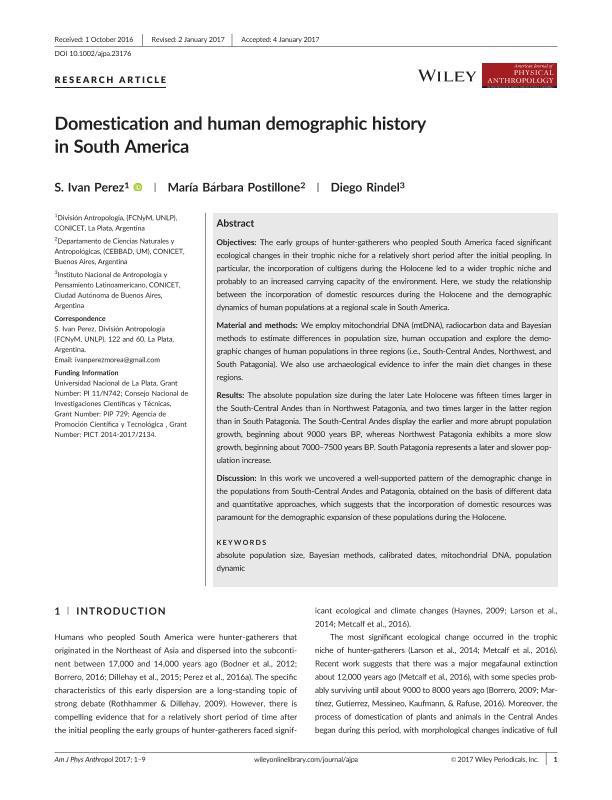Mostrar el registro sencillo del ítem
dc.contributor.author
Perez, Sergio Ivan

dc.contributor.author
Postillone, María Bárbara

dc.contributor.author
Rindel, Diego Damián

dc.date.available
2018-07-25T17:33:55Z
dc.date.issued
2017-05
dc.identifier.citation
Perez, Sergio Ivan; Postillone, María Bárbara; Rindel, Diego Damián; Domestication and human demographic history in South America; Wiley-liss, Div John Wiley & Sons Inc; American Journal Of Physical Anthropology; 163; 1; 5-2017; 44-52
dc.identifier.issn
0002-9483
dc.identifier.uri
http://hdl.handle.net/11336/53090
dc.description.abstract
Objectives: The early groups of hunter-gatherers who peopled South America faced significant ecological changes in their trophic niche for a relatively short period after the initial peopling. In particular, the incorporation of cultigens during the Holocene led to a wider trophic niche and probably to an increased carrying capacity of the environment. Here, we study the relationship between the incorporation of domestic resources during the Holocene and the demographic dynamics of human populations at a regional scale in South America. Material and methods: We employ mitochondrial DNA (mtDNA), radiocarbon data and Bayesian methods to estimate differences in population size, human occupation and explore the demographic changes of human populations in three regions (i.e., South-Central Andes, Northwest, and South Patagonia). We also use archaeological evidence to infer the main diet changes in these regions. Results: The absolute population size during the later Late Holocene was fifteen times larger in the South-Central Andes than in Northwest Patagonia, and two times larger in the latter region than in South Patagonia. The South-Central Andes display the earlier and more abrupt population growth, beginning about 9000 years BP, whereas Northwest Patagonia exhibits a more slow growth, beginning about 7000–7500 years BP. South Patagonia represents a later and slower population increase. Discussion: In this work we uncovered a well-supported pattern of the demographic change in the populations from South-Central Andes and Patagonia, obtained on the basis of different data and quantitative approaches, which suggests that the incorporation of domestic resources was paramount for the demographic expansion of these populations during the Holocene.
dc.format
application/pdf
dc.language.iso
eng
dc.publisher
Wiley-liss, Div John Wiley & Sons Inc

dc.rights
info:eu-repo/semantics/openAccess
dc.rights.uri
https://creativecommons.org/licenses/by-nc-sa/2.5/ar/
dc.subject
Absolute Population Size
dc.subject
Bayesian Methods
dc.subject
Calibrated Dates
dc.subject
Mitochondrial Dna
dc.subject
Population Dynamic
dc.subject.classification
Otras Ciencias Biológicas

dc.subject.classification
Ciencias Biológicas

dc.subject.classification
CIENCIAS NATURALES Y EXACTAS

dc.subject.classification
Historia

dc.subject.classification
Historia y Arqueología

dc.subject.classification
HUMANIDADES

dc.title
Domestication and human demographic history in South America
dc.type
info:eu-repo/semantics/article
dc.type
info:ar-repo/semantics/artículo
dc.type
info:eu-repo/semantics/publishedVersion
dc.date.updated
2018-07-25T13:52:16Z
dc.journal.volume
163
dc.journal.number
1
dc.journal.pagination
44-52
dc.journal.pais
Estados Unidos

dc.journal.ciudad
Nueva York
dc.description.fil
Fil: Perez, Sergio Ivan. Consejo Nacional de Investigaciones Científicas y Técnicas; Argentina. Universidad Nacional de La Plata. Facultad de Ciencias Naturales y Museo; Argentina
dc.description.fil
Fil: Postillone, María Bárbara. Consejo Nacional de Investigaciones Científicas y Técnicas; Argentina. Universidad Maimónides. Área de Investigaciones Biomédicas y Biotecnológicas. Centro de Estudios Biomédicos, Biotecnológicos, Ambientales y de Diagnóstico; Argentina
dc.description.fil
Fil: Rindel, Diego Damián. Consejo Nacional de Investigaciones Científicas y Técnicas; Argentina. Secretaría de Cultura de la Nación. Dirección Nacional de Cultura y Museos. Instituto Nacional de Antropología y Pensamiento Latinoamericano; Argentina
dc.journal.title
American Journal Of Physical Anthropology

dc.relation.alternativeid
info:eu-repo/semantics/altIdentifier/doi/https://dx.doi.org/10.1002/ajpa.23176
dc.relation.alternativeid
info:eu-repo/semantics/altIdentifier/url/https://onlinelibrary.wiley.com/doi/abs/10.1002/ajpa.23176
Archivos asociados
